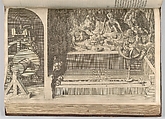Problem XXIIII: A Machine for a Moveable Galatea in a Grotto, in: Les Raisons des Forces Mouvantes, plate 32
Designed by Salomon de Caus French
Publisher Jan Norton German
Not on view
Salomon de Caus (1576–1626) was a unique figure in garden history. Trained as an architect-mathematician and hydraulic engineer, he was renowned not only for his garden designs with magnificent waterworks, but also for his many publications on topics relating to the arts and sciences. His most influential works include the Hortus Palatinus (1620) on his Heidelberg garden designs, and Les raisons des forces mouvantes (1615), setting out the principles of hydraulics on which the automata or trick fountains and water jokes in the seventeenth-century garden were based. Familiar with the waterworks in Italian Renaissance gardens (Villa d'Este, Tivoli, and Pratolino, Florence), ultimately derived from the just reissued works of Hero of Alexandria (first century A.D.), de Caus introduced hydraulics into the Northern European garden. His influence was widespread at the courts of the Southern and Northern Netherlands, Germany, and also England, where his younger brother Isaac de Caus worked.
The print illustrated here shows one of de Caus's contrivances, consisting of a moving sculpted vessel with a figure of Galatea drawn by dolphins, which would greatly surprise—and probably completely soak—the innocent bystander. This and similar mechanical marvels were generated by concealed pipes creating forceful water jets and included acoustic devices which copied sounds of animals (chirping birds), as well as thunder, wind, and rain.
Due to rights restrictions, this image cannot be enlarged, viewed at full screen, or downloaded.


